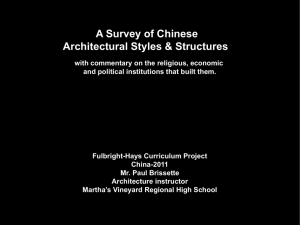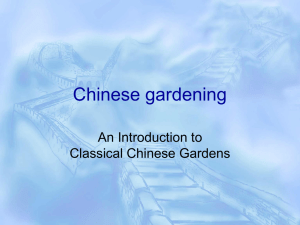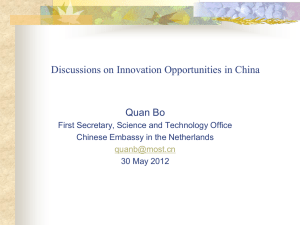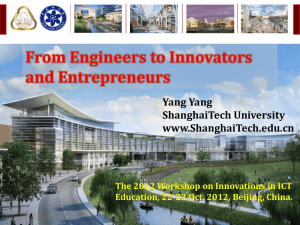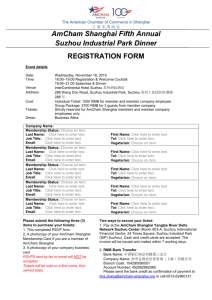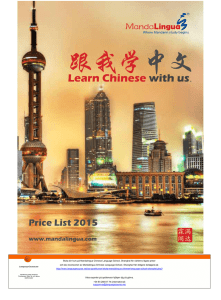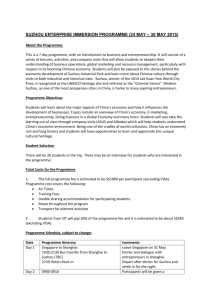Chusok Trip to China 2002
advertisement
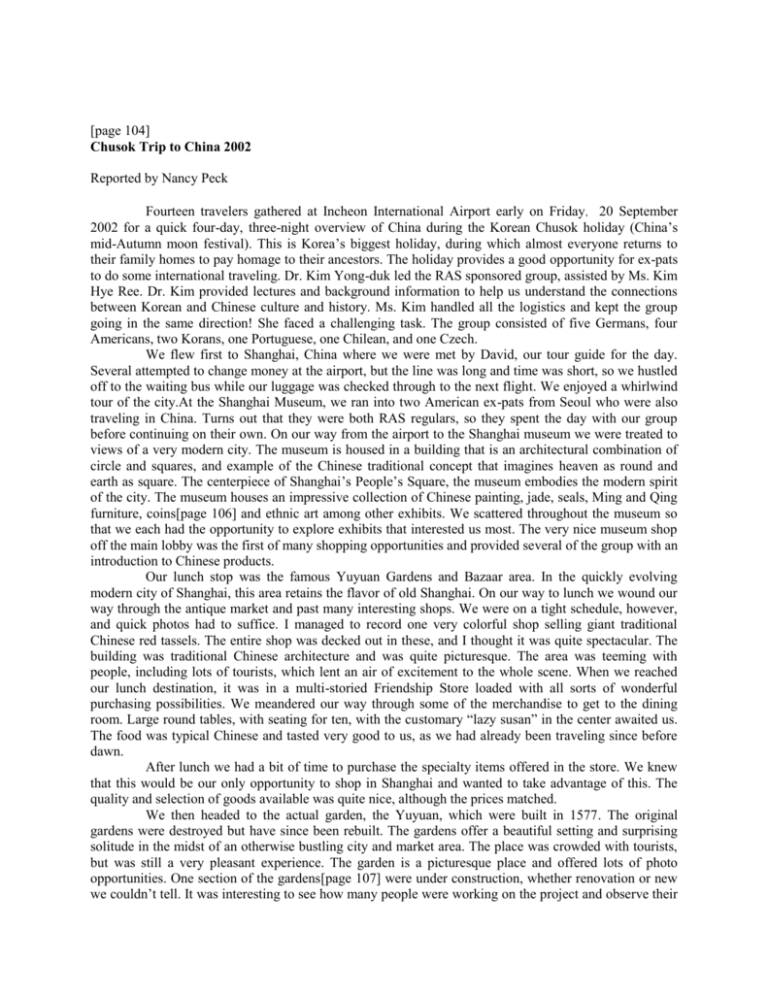
[page 104] Chusok Trip to China 2002 Reported by Nancy Peck Fourteen travelers gathered at Incheon International Airport early on Friday,20 September 2002 for a quick four-day, three-night overview of China during the Korean Chusok holiday (China’s mid-Autumn moon festival). This is Korea’s biggest holiday, during which almost everyone returns to their family homes to pay homage to their ancestors. The holiday provides a good opportunity for ex-pats to do some international traveling. Dr. Kim Yong-duk led the RAS sponsored group, assisted by Ms. Kim Hye Ree. Dr. Kim provided lectures and background information to help us understand the connections between Korean and Chinese culture and history. Ms. Kim handled all the logistics and kept the group going in the same direction! She faced a challenging task. The group consisted of five Germans, four Americans, two Korans, one Portuguese, one Chilean, and one Czech. We flew first to Shanghai, China where we were met by David, our tour guide for the day. Several attempted to change money at the airport, but the line was long and time was short, so we hustled off to the waiting bus while our luggage was checked through to the next flight. We enjoyed a whirlwind tour of the city.At the Shanghai Museum, we ran into two American ex-pats from Seoul who were also traveling in China. Turns out that they were both RAS regulars, so they spent the day with our group before continuing on their own. On our way from the airport to the Shanghai museum we were treated to views of a very modern city. The museum is housed in a building that is an architectural combination of circle and squares, and example of the Chinese traditional concept that imagines heaven as round and earth as square. The centerpiece of Shanghai’s People’s Square, the museum embodies the modern spirit of the city. The museum houses an impressive collection of Chinese painting, jade, seals, Ming and Qing furniture, coins[page 106] and ethnic art among other exhibits. We scattered throughout the museum so that we each had the opportunity to explore exhibits that interested us most. The very nice museum shop off the main lobby was the first of many shopping opportunities and provided several of the group with an introduction to Chinese products. Our lunch stop was the famous Yuyuan Gardens and Bazaar area. In the quickly evolving modern city of Shanghai, this area retains the flavor of old Shanghai. On our way to lunch we wound our way through the antique market and past many interesting shops. We were on a tight schedule, however, and quick photos had to suffice. I managed to record one very colorful shop selling giant traditional Chinese red tassels. The entire shop was decked out in these, and I thought it was quite spectacular. The building was traditional Chinese architecture and was quite picturesque. The area was teeming with people, including lots of tourists, which lent an air of excitement to the whole scene. When we reached our lunch destination, it was in a multi-storied Friendship Store loaded with all sorts of wonderful purchasing possibilities. We meandered our way through some of the merchandise to get to the dining room. Large round tables, with seating for ten, with the customary “lazy susan” in the center awaited us. The food was typical Chinese and tasted very good to us, as we had already been traveling since before dawn. After lunch we had a bit of time to purchase the specialty items offered in the store. We knew that this would be our only opportunity to shop in Shanghai and wanted to take advantage of this. The quality and selection of goods available was quite nice, although the prices matched. We then headed to the actual garden, the Yuyuan, which were built in 1577. The original gardens were destroyed but have since been rebuilt. The gardens offer a beautiful setting and surprising solitude in the midst of an otherwise bustling city and market area. The place was crowded with tourists, but was still a very pleasant experience. The garden is a picturesque place and offered lots of photo opportunities. One section of the gardens[page 107] were under construction, whether renovation or new we couldn’t tell. It was interesting to see how many people were working on the project and observe their construction methods, which seemed quite different from what we are accustomed to seeing in the west. We took a leisurely stroll around the garden and then on to the bridges over ponds surrounding the famous Huxinting Tea House. It would have been fun to have tea in this ancient wooden building, but it is quite expensive and we had just had tea during lunch, not to mention the extra time we would have needed. We settled for photos and noticed a Starbucks coffee practically next door for those preferring a modern counterpart. There are boardwalks across the ponds surrounding the teahouse and the water fountains were spouting their displays. The day was beautiflil and sunny and the scenery quite impressive. Once again boarding our bus, we toured the city on the way to the Bund, also known as Waitan. This is the street with all the famous commercial buildings built in the 1920s and 1930s. Standing on the harbor-side, we could look at all the buildings and across the Huangpu River to the new Pudang section of Shanghai, with the Pearl of the Orient television tower, high-rise hotels, and other new development. There is also a high-rise expressway, which allows traffic to move quite well and affords travelers sweeping vistas of the city as they pass by. Shanghai residents, in an effort to move around the city, often travel by bicycle. The bikes queue up at the intersections waiting for the lights to change and then rush off en masse. We had a little time before we had to be back at the airport for our next flight, so there was time to visit a silk carpet factory and showroom. The carpets were really fantastic and quite amazing to see the girls laboring at them. Apparently young girls make the best workers. Probably because the yarns and patterns are so fine that anyone over 25 wouldn’t be able to see them, nor would their fingers be nimble enough for the extremely fine work. We had an explanation about the different qualities of carpets and learned a bit more about what to for when buying carpets. It was time to return to the airport to fly to Zhangjiajre, which used to be[page 108] called Dayong. Located in Hunan province, the city is a couple of hours west of Shanghai by air. The new name is very difficult for non-Chinese to pronounce, and we all tripped over the pronunciation for the next few days. Hunan province has some of the richest agricultural land in China. Zhangjiajie is home to three of the province’s minority peoples. The flight to central China was packed as the Chinese were celebrating mid-Autumn Moon Festival the next day. Lots of people were traveling, perhaps to be with families. The flight was uneventful and we all disembarked upon landing and made our way across a little-lit airport to the terminal. We commented that we were glad we were the only flight landing. We waited for our luggage which soon arrived at the terminal door on a trailer That was as far as it was going. It was up to each of us to find our own bags, pull them off the truck, and to do this in the dark. Quite interesting. Most were good sports and it worked out all right. Our guide for the next two days, Ms. Zheng, also known as Ganory, met us and shepherded us into our waiting bus. Also along for the ride was a young man who would be video taping our stay in the area. The Chinese have caught on to the capitalist system and have figured out how to make money at every turn. We learned that a majority of the tourists to the area are Korean. In fact, on the first night our guide assumed we were Korean, since we were coming from Korea, and that we would want Korean food. Our international group assured her that we were looking forward to Chinese food and a change of meal plans was telephoned ahead to the restaurant, which graciously accommodated our last minute adjustment. It was late evening, around 8 p.m., and we were really ready to eat. One of the dishes was a tomato and scrambled egg mixture, along with many other dishes, too, but the tomato-egg dish would find its way into nearly every meal we ate in the central Hunan area. The hotel in Zhangjiajie was modern and quite nice. The area is a tourist zone, and in 1984 Zhangjiajie, Suoxiyu Valley and Tianzi Mountain, an area of 369 square kilometers was formally named Wulingyuan. In 1988 the[page 109] State Council designated the area as a scenic area, and in 1992 UNESCO placed the area on the World Heritage list as a cultural and natural site of exceptional and universal value. Wulingyuan comprises a lofty forest, crystal clear lakes, limpid streams and above all, its unique karst topography. The quartzite sandstone crags and canyons are really quite a spectacle. Day two dawned early and the first order of business was to try to exchange money. Although it was 8 a.m. Saturday morning, and a holiday, we were assured that a bank would be open. Not just any back, though, as it have to be a bank that was authorized to exchange foreign currency. Our group strained the bank’s cash reserves in our desire to acquire local currency. Eight Yuan equals about 1 US Dollar, and while most of us didn’t exchange a great deal of currency, money seems to go much further in China. Waiting on the busy street comer while everyone finished their banking transactions we were interested in observing the local folks, but not quite sure which was the more curious, us or them! We were especially intrigued by a small local parade moving past and a transaction involving a chicken sale. The chicken was transported in a basket on the seller’s back and negotiations were held right in front of us before the chicken was finally carried off by the buyer. Traveling into the National Park area, rural housing tended to be two storied brick structures. They seemed quite substantial. Most houses appeared to have electricity and tile roofs. Crops of rice and various vegetables were plentiftil and nearly ready for harvest. We saw lots of fruits and mushrooms in the local markets. The Zhangjjajie area seems to be prospering and there is a lot of construction and modernization. Bamboo scaffolding and plenty of manual labor was witnessed. Workers carry loads balanced on poles carried over the shoulders. We saw all sorts of things being carried by this method, including dirt, luggage and market supplies. We did see some of the locals in the area carrying baskets with straps on their backs. These would have made interesting souvenirs, but we didn’t see them for sale anywhere. This contrasts with the Korean method of carrying[page 110] loads in a-frame carriers. Merchants were eager to sell their goods, but no quite so desperate that they came running after us as has happened in the past. There were many colorful ethnic clothing articles, dolls, cloth bags and purses, wood products and stone whistles for sale. The garments had lots of embroidery and some featured commercial trim. We kept seeing the same things for sale throughout the area, so the merchandise may be made in bulk somewhere in the region. The locals were well dressed in western style clothing. Now that we were freshly armed with local currency, we moved on to the National Park to experience the fascinating karst formations. First we had to activate our electronic tickets that would be good for several re-entries in the park. To accomplish this, we had to insert our tickets and leave our thumbprint. We weren’t quite sure why we needed to do this, but it came clear the second day when we entered on the same ticket and our thumbprints had to match! Quite a high-tech system for the backwoods. We walked for several kilometers along a riverbank through the Golden Whip Stream valley. The path was paved and relatively level; an easy walk. The first part was a coordination/exercise challenge which most opted to try. Our photographer was on hand to record our adventures on this day. Beautiful scenery, swinging bridges, interesting signs along the trail?lots of photo opportunities, including having some photos taken by locals with scenery in the background. Unbelievably, these local photo merchants had digital cameras and computers set up in the woods. After some looking, we discovered a cable discreetly hung in the trees powering all these electronic marvels. At one point in our travels through the national park, we were entertained by a Ferris-wheel device which carried four passengers. Care in boarding was maintained for balance, but once in motion it took two men to stop it from wildly spinning around. A couple of men and women tried it out. It must have been exhilarating. Those who didn’t wish to walk the trail could avail themselves of some of[page 111] the teams of porters who would have been happy to transport paying customers on their sedan chairs supported by long bamboo poles. None of our group chose this means of conveyance, but the porters were friendly and didn’t seem to mind us taking their picture. Along the trail were dancers dressed in traditional garb and providing entertainment through dance and music. Souvenir, beverage and snack vendors along the trail provided many opportunities for refreshment or bargain hunting. We couldn’t speak Chinese and they couldn’t speak English, but communication took place through charades, pencils and paper, and calculators. Bartering seems to transcend language and is fun for everyone. There were many people walking and enjoying the park. Walking along the gently sloping paved path along the riverbank was very peaceful. The woods were dense, but looking up we were treated to magnificent limestone karst formations. Everyone one looked seemed picture perfect. We hiked for a couple of hours, noticing that the trash barrels were in the shape of tree trunks and blended well with the landscape. Even the safety railings, made of concrete, were designed to appear as logs or bamboo. The park was clean and well maintained. Most signs included English translations. Once through the Golden Whip Stream Valley, we traveled to another area to see the Gallery Valley. The rock formations have all been given names and those seen in Gallery Valley appear as subjects in paintings. We had just walked for a couple of hours and several kilometers, so many of our group chose to ride the train up the hill to the viewing area. Our photographer opted to job up the hill so he could get photos of us disembarking and enjoying the views. This time, though, he was the subject of photos as we snapped away while he was jogging alongside the tracks. The train had small two-person compartments with glass roofs making it easy to view the rock formations towering above. The river valley was filled with tall pampas grass and didn’t appear to have much water despite the recent heavy fall rains. We returned to town for a traditional lunch which included many[page 112] vegetables and the local somewhat spicy food. It was the Moon Holiday, so we were treated to the sweet and nutty moon cakes. Other popular Moon Festival activities include gazing at the moon and lighting fireworks. It is also a traditional holiday for lovers. After lunch we visited a local studio that produces, displays and sells embroidered and painted landscapes. The regional geography certainly offers plenty of inspiration for artists. We spent the afternoon exploring the Yellow Dragon Cave, joining numerous other tour groups for the guided tour through the cave. Our guide, as well as all the others, carried a small megaphone to explain the wonders of China’s largest cavern. You can imagine the din of the competing guides as they each talked to their groups. The paths through the cave were constructed of cement which made walking comfortable. The cavern sights were fabulous, with lighting strategically placed to highlight and show off the best features. We rode a boat on the river that winds through the cavern, viewing the pools, stalactites, stalagmites, pillars and columns. The engineering of the walkways, steps and bridges also impressed us. There were a lot of steps and it took a couple of hours to walk through the entire cave. By the time we emerged, our city legs realized that we had given them plenty of exercise. A rainstorm greeted our exit, so we rushed past the many vendors, but one member of our group stopped long enough to purchase some of the geodes to add to her collection. The weather on our third day, Sunday, really cooperated for our viewing of the mountains. We drove along exciting mountain roads to get to Tianzi Mountain. The cable car station seemed like it was half-way up the mountain, but the walk was worth it. The view from the nearly 20-minute long cable car ride was breathtaking. We passed close to the peaks, right over others, and cliffs with huge dropoffs. The views were spectacular. Once we reached the top the views of the surrounding area stretched for miles. The rain the night before had made the air clear and we enjoyed it so much. [page 113] A shuttle bus transported us to a memorial park at a lower elevation, and were delighted with our exploration (despite having to climb lots of steps) of the park. The views of the canyon from above the karst peaks were magnificent. We discovered why this place was so popular and exciting! A tea shop visit after lunch introduced us to traditional Chinese tea making. We enjoyed tasting several types of tea, including one kind made from the droppings of silk worms. It sounds terrible, but didn’t taste too bad, and no one got sick, so it must be ok to drink, but I don’t think anyone bought any to take home! Our next stop was Baofeng Lake, where another hill climb faced us from the bus parking area. There was a beautiful waterfall and pool area, almost too perfect to be natural. The scenery was beautiful, but our city legs were really screaming for relief! A gentle walk into the woods brought us to the rhesus monkey park, where they were all having a great time. They were caged, sort of, but seemed to be able to escape their confinement although they didn’t seem to wander too far. A continued walk brought us to the lake shore where we boarded our excursion boat. Gliding past numerous islets covered with trees and vegetation, we observed that the lake is an area completely surrounded by mountains that seems to have simply filled with water. At various stops on our cruise, entertainers provided song and dance depicting traditional cultures and customs. Having returned to Shanghai Sunday night, our itinerary for Monday was a trip to Suzhou, which took about 1.5 hours by bus. We passed through many farms and lots of beautiful countryside. Suzhou is one of the oldest towns in the Yangtze (Jangjiang) Basin, dating back some 2500 years. With the completion of the Grand Canal in 609 CE, Suzhou grew rapidly as a center for shipping and grain storage. Marco Polo visited the city c. 1276 and described is as “great and noble” and mentioned that its population included great sages, physicians, and magicians. By the 14th century, Suzhou became China’s leading silk producer, during which era the wealthy inhabitants of the city created many beautiful gardens, of which[page 114] some 100 or more survive to the present time. When the oppressed silk workers staged a series of violent strikes in the 15th century, the industry began shifting its focus away from Suzhou. The city is fortunate in that it was by-passed by the misfortunes of the 19th and 20th centuries (the Taiping Rebellion, the Japanese occupation, and the Cultural Revolution (1966- 1976). Because of its many canals and bridges, Suzhou is sometimes referred to as the “Venice of the East.” Today it is an industrial center, with factories producing electronics, machinery, optical instruments, boat building,chemicals, etc. And silk reeling and weaving has returned to Suzhou, making it renowned once again for its fine silk goods. We arrived at Tiger Hill just in time for a parade of traditionally costumed performers. It was colorful and spectacular. Our timing couldn’t have been better. The parade included a dragon dance and lion dancers, as well as performers on stilts and others transported in sedan chairs. It was loud and picturesque. We followed them through the compound,but with our tight schedule we couldn’t linger to watch their performance. Our visit to Suzhou also included a stop at a silk factory where we watched a demonstration on how wet cocoons are opened and the silk stretched into silk caps. It takes up to twentyfive cocoons to make one cap. The make blanket filler, four women then stretched the wet caps even further. We had only twenty minutes to shop, but some of us could easily have spend a couple of hours in order really see everything! We concluded our visit with a tour of the Humble Administrator’s Garden, which dates from the early 1500s and is quite large. The garden features streams, lily ponds, bridges, islands of bamboo, pavilions and teahouses. A large fall floral peacock greeted us and there were fall floral arrangements strategically placed throughout thegardens. There we many good ideas for using plants and making good use of small spaces. The weary RAS travelers then headed back to the Shanghai airport through rush hour traffic, arriving in time to check in and board our flight back to[page 115] Korea. The trip was quick, but packed with lots of stimulating sights, good exercise, and good memories. Another successful RAS event! Commentary on the Trip Dr. Kim Yong-duk, Tour Leader Archaeologists have concluded that rice cultivation originated at a site called Hamoto near Shanghai some seven thousand years ago, and reached Korea in the Ilsan area north of Seoul about five thousand years ago. Rice farming has been discovered in Japan along the northern shore of Kyushu only as early as about two thousand five hundred years ago. The migrations of people can be traced in this manner, but we can also conclude that cultivation revolutionized the ancients’ ways of life. Coins of the Han Dynasty (2nd Century BCE to 2nd Century CE), and earlier, are on display in the Shanghai museum. Some of these coins have been found in Chejudo, Korea, indicating contact and even possibly trade between them and China at that early period. Paekche and Shilla peoples also colonized the Chushan Archipelago near Hangzhou Bay, south of Shanghai. Arabian traders at an early era recorded that inhabitants of these islands were so rich that even dog leads were made of gold. One of the several ethnic minorities living in the Zhangjiajie region are the Zhangzo, who reside in a place which is called the “ruins of Paekche.” Apparently a “tamno” or colony of the Paekche kingdom existed in that region at least until the downfall of Paekche c. 660 CE. This fact was discovered when the tombstone of the feudal lord Heukchi (Black Teeth) was uncovered recording the fact that he was the great grandson of the viceroy of Paekche who had been appointed to rule the area. Yangdi, the second emperor of the Sui kingdom, built the Great Canal as a means of conveying soldiers and war materiel to northern China. Eventually, he sent a one million strong force to invade Koguryo, but was [page 116] defeated whereupon a military coup d’etat overthrew the kingdom and established the Tang kingdom. Years later, the founder of Tang’s grandson finally succeeded in conquering war-weary Koguryo who had been fighting the Chinese for over seventy years. The 2500 km long Great Canal served the nation well for hundreds of years providing for the economic cohesion of China. This canal passes through Suzhou (which had hundreds of bridges over the many streams and canals in the region), and boasts of more than one hundred elegant gardens still surviving out of more than 400 that were built since the Ming kingdom. There are some interesting points of similarity as well as differences between Korean and Chinese gardens, but the four elements of rock, water, plants, and pavilions are found in both garden cultures, as well as those of Japan. The oldest extant rockery is found not in China, though, but in what was the Koguryo palace garden near Pyongyang. The oldest known two- tiered humanmade waterfall is found in Kyongju, built in Shilla times. Chinese love to use odd-shaped rocks in their gardens, while Koreans tend to use roundish, flat rocks. Pavilions are also constructed differently in the three garden cultures (pointed roofends in China, gently curved roof lines in Korea, and straight roof lines in Japan). Korean pavilions are often built with the pillars founded in the pond bottom. This is rare in China and not found at all in Japan. Chinese gardens feature junipers, Koreans love pine trees, and Japanese gardens often feature cherry trees.

